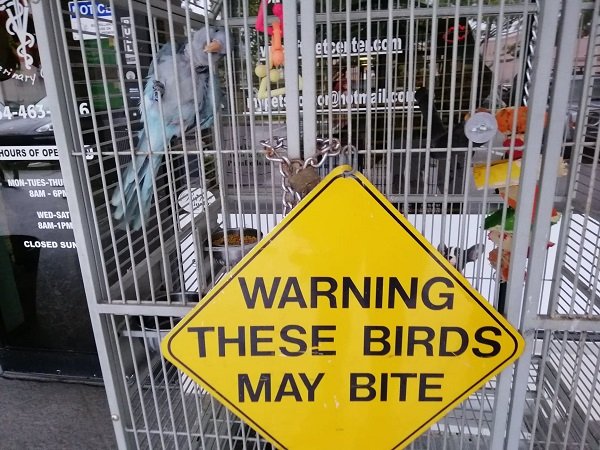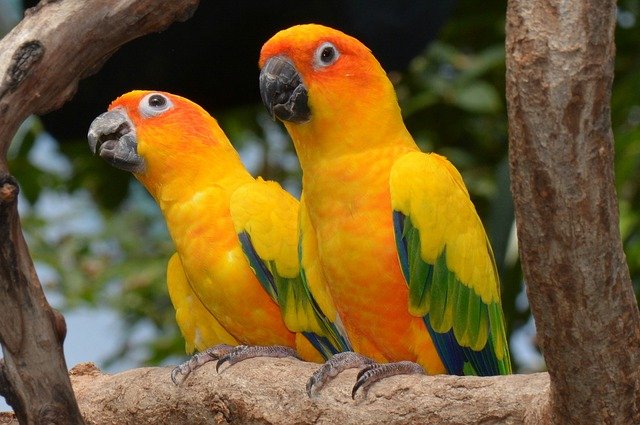Sun Conure is a vividly colored parrot native to northeastern South America. Sun Conure or as they are commonly called Sun Parakeet, are confined only to a small region of the continent: southern part of Guyana, southern French Guiana, Roraima (state of northern Brazil), and Suriname’s extreme southern part.
But, nowadays, you’ll find them more in people’s houses than in their natural habitat due to their popularity among avian lovers. In the past years, they have become a preferred pet of those who love owning brightly colored fauna.
Sun Conure Color
Sun conure is a beautiful cocktail of colors with varied shades. When young, green color dominates sun conure, more specifically, his plumage is green, unlike an adult sun conure. The green color changes into red, yellow and orange after his infancy days.
When adults, the color of the plumage changes from green to golden-yellow. The bright shade of yellow color predominates the crown, nape, chest, and mantle.
The face and belly sport a soft reddish-orange color with ears being flushed red. Talking about the color pattern on wings, it has all the possible colors, with the greater wing coverts base being green, lesser wing-coverts being bright yellow, and the majority of primary coverts being dark blue. And from beneath, all of his flight feathers are a dark-grey tone.
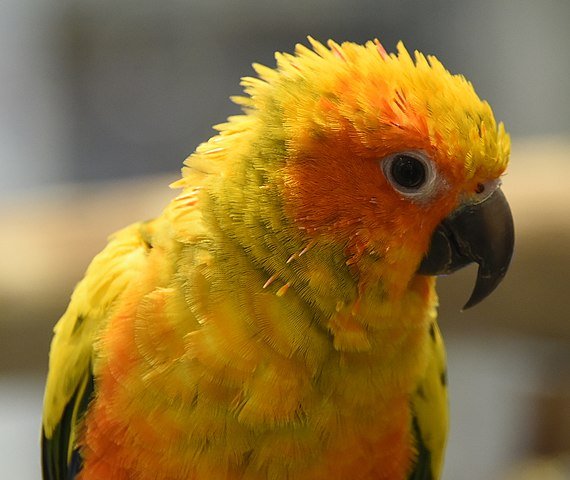
The tail of a sun conure is of olive-green color with a blue tip. The legs and eye-ring of the conure are generally grey but in captivity its eye-ring color changes to white just like a Macaw. Both sexes do not have much difference in color markings and most of the times, look identical.
Read more about Sun Conure Breeding:
https://parrotsinfo.net/sun-conure-breeding/
Sun Conure color similarity with other Conures
Sun Conure is many times confused with other Conures due to the similarities in color shown by these birds. In the first look, one can easily get confused by a similar-colored bird if proper knowledge of other related Conure species is lacking. It is, therefore, essential to know the differences between Sun Conures and the birds they are confused with.
Sun Conures vs Jenday Conure
The size and shape of both Sun Conure and Jenday Conure are exactly the same. An adult Jenday Conure has a bright orange and yellow head which is quite similar to Sun Conure. One distinctive feature of Jenday Conure is the color of this bird’s plumage. All the wing-coverts are green in color showing no signs of yellow as in the case of Sun Conure. The tips of Jenday’s wings, however, show signs of iridescent blue to add to the confusion.
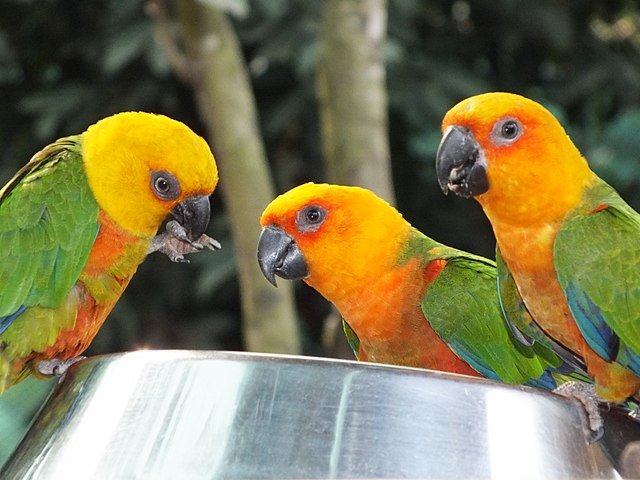
The tail of Jenday Conures is covered with blue feathers whereas in the case of Sun Conures only the tip of the tail is blue with the whole tail being olive-green colored.
The mantle and vent of Jenday Conures are green colored as against yellow in the Sun Conures. Both these parrot species appear similar when young as green color dominates in them at that point of age. As they grow, yellow and orange colors begin to appear in Sun Conures while Jenday Conures have many appearances of these colors.
One can, therefore, distinguish a Sun Conure from a Jenday Conure by observing the color of wings which are primarily yellow in the case of former and green in case of the latter.
Sun Conures vs Sulphur-breasted Conure
Sun Conure and Sulphur-breasted Conure strike an extreme resemblance in their color. Though they represent two different species, they are also sometimes considered as representing a single species.
Both the parrot species are similar in size and shape which makes it all the more difficult to distinguish them apart. One can clearly separate a Sulphur-breasted Conure from a Sun Conure by observing his mantle which has a lot of green mottling over it while the yellow color predominates the mantle of Sun Conure. Also, Sulphur-breasted Conure has less orange tint at his belly than the Sun Conure. These two basic differences help one distinguish between these species.
Sun Conure Color Mutations
With so many colors in his genes, a sun conure’s color mutations were inevitable. Breeders always try to make an already beautiful creature more fascinating by selective breeding. This is what happened with this member of conure species too.
Apart from the yellow factor sun conure i.e. the original species, the pet owners have the option of owning the following two beautiful mutations, courtesy breeders:
1 ) Red Factor Sun Conure
This is a rare color mutation of the sun conure but is equally beautiful and fascinating. It was first seen in Hawaii in the early 1990s. Since then, it has caught the attention of American breeders who have collected these little parrots for in-house breeding or to make them available for the lovers of this mutation.
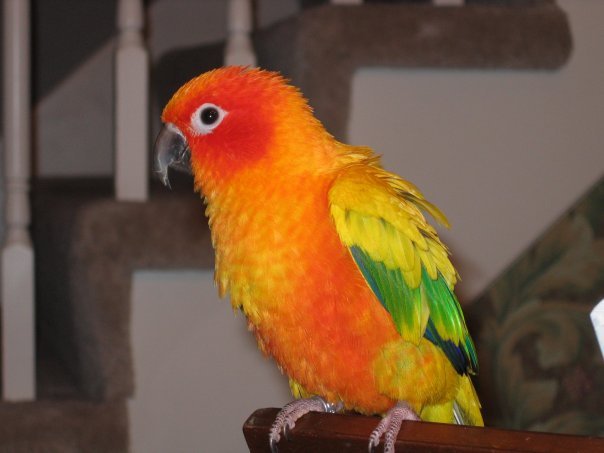
A red factor sun conure has dominant inheritance which means that either of the parents has to be a visibly red factor to carry the gene to give birth to a red-colored offspring. If a sun conure is just red in color normally but does not, specifically, carry the red factor genes, it is impossible for him to produce a red factor baby sun conure.
A baby red factor sun conure has a soft red wash all over his body over a natural yellow color. He’ll have bluish-red tinge at the tips of their feathers, back, and upper wing coverts.
He can be distinguished visibly from a normal yellow sun conure baby as they have a green tinge all over their body. A red factor will not have orangish patches like a normal baby sun conure. He will become a more dark and brighter shade of red after his first molt at around the age of 3 months.
After his first molt, a red factor’s yellow tinge wash out and he’s red in real sense. The tone of that color, however, may differ from bird to bird ranging from light-red to reddish-orange or to a medium reddish-orange. But this tinge will be consistent throughout his body namely, head, chest, belly, legs, and under-wings.
After a red factor sun conure ages, his red color starts to fade away. The brightness is quite dull but he can still be identified as a red factor sun conure.
2 ) Pied Sun Conure
A recent successful attempt created a pied mutation of sun conure by recessive inheritance of the gene. The pied sun conure is also visually different from that of a normal sun conure. As against a combination of several colors in a normal sun conure, the pied mutation is mostly yellow.
A baby pied sun conure has a very bright yellow color as compared to the normal one who is mostly green when an infant. They lack the red pigment.
A young pied sun conure, after his first molt, gets a new feather of the brightest yellow. He’ll have very little dots of blue or green here and there on their body or none at all. The feather could also be little white at the tips apart from bright yellow.
The tip of the tail can also be white in some pied conures. Initially, his beak would be white but it will eventually become black with time. His feet will also be of white color against black in the normal sun conure.
Failed Sun Conure Color Mutation
Like many other parrot species, this mutation is developed through the cumulative color inheritance technique. Two red factor sun conures are bred to have a more colorful offspring called double red factor sun conure. The offspring would be of darkest-red, in fact, almost bronze colored.
But this technique has a saturation point in case of red factor conures and the new baby is born with metabolic malfunction. They are pretty much normal when born but by the age of 2 or 2.5 months, their motor functions start failing and eventually they cannot fly or even eat on their own. An autopsy has confirmed brain lesions and metabolic malfunctioning in all of them. Seeing youngsters dying such a painful death has, luckily, discouraged the breeders to create a darker shade of red factor sun conure this way.
Not a Sun Conure Color Mutation
There has also been a ‘supposed’ turquoise sun conure out there for pet lovers but the truth is that it is not a sun conure color mutation. The turquoise sun conure that many breeders are selling to the sun conure lovers is actually a color mutation of another species from a conure family known as green-cheeked conure. The turquoise green-cheeked conure is a rare and recent creation of breeder’s attempts and are hard to find. But it does not belong to the sun conure family at all.
Another sun conure color has got the pet owners confused which has more of deep-orangish domination all over his body. Due to this tangerine wash, he has been given the name of Tangerine sun conure which is quite incorrect. There has been no such reported attempt to create this color mutation. A normal sun conure also carries the orange color and there is always a possibility of an offspring to inherit that gene color from both the parents predominantly. Hence, a more tangerine looking offspring is born. But that doesn’t mean that he is a color mutation.
Most of the photos are Creative Common from www.wikipedia.org
Wayne Deeker / CC BY
Read How to improve the quality of Sun Conure Life & His lifespan:
https://parrotsinfo.net/4-ways-to-improve-your-sun-conure-lifespan/

